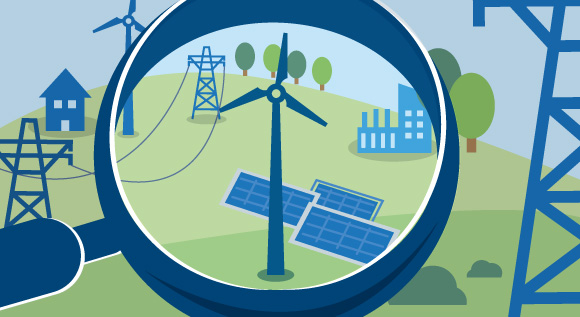What exactly is “direct marketing”?
Producers of electricity from renewables generally have to market it themselves. What does this have to do with farmers, tomatoes and better energy security? Here are the answers.
 © BMWi
© BMWiGenerating and marketing electricity from renewables
If you want to buy fresh vegetables, you will usually pop into a supermarket. You’ll find everything your heart – and your stomach – desire: tomatoes, potatoes, carrots and all sorts of other tasty produce. The supermarket buys (at least some of) these products from farmers in the region and sells them on to its customers.
For a long time, that was also how trade in electricity from renewable energy worked. The operators of wind, solar and biomass energy installations passed on their electricity to the transmission system operators (TSOs). In return, they received money to cover their costs. The TSOs sold the electricity on the electricity exchange. That is where electricity is purchased by the energy utilities and can thus make its way to the final consumer. The difference between the amount paid to the operators of the renewable energy installations and the amount earned by the TSOs at the exchange is passed on to all the electricity consumers in the shape of the “EEG surcharge”.
But everyone in the countryside knows that’s not the only way to buy and sell food: that they can get their tomatoes direct from a trusted farmer rather than from the supermarket. This “direct marketing” was introduced for electricity from renewables in 2012 – initially on a voluntary basis, and then from 2014 it was made compulsory for all installations above a certain size (starting from 100 kilowatts at present). Since then, the installation operators haven’t been able simply to sell their electricity to the TSOs. They have to market it themselves, or get someone to market it for them, on the electricity exchange.
The system works
Even though it’s called “direct marketing”, most operators don’t sell their electricity on the exchange themselves. Instead, they hand this task to a company, a “direct marketer”, which specialises in it. The operator now receives its money from a direct marketer, who sells the electricity on the exchange. Since the revenues from the exchange are not normally enough to refinance the cost of the installations, a market premium is also paid. The operator receives from the direct marketer a combination of the selling price on the exchange and the market premium, minus a commission for the direct marketer.
And this is where it gets interesting: Those generating electricity from a small renewables-based installation (less than 100 kilowatts) do not have to market the electricity themselves. They receive remuneration fixed by the state – say 12 cents per kWh. If an operator who has to market his electricity directly only gets 4 cents per kWh on the exchange, he will be at an obvious disadvantage. That is why those marketing their electricity directly are entitled to a market premium. It offsets the gap between the average price on the exchange and what is called the “value to be applied”. This value is – simplifying it slightly – comparable to the fixed remuneration set by the state, but it is now (since the beginning of this year) no longer being set by government, but determined by auction (find out more about auctions here). If the value to be applied is also 12 cents per kWh, the market premium will offset the difference between that and the 4 cent price on the exchange, i.e. the premium will be 8 cents.
Since the calculation of the market premium is based on the average monthly price on the electricity exchange, those who are good at marketing their electricity directly and deploying their installation can earn more than the 12 cents: if a particularly large quantity of electricity is in demand on a certain day, so that the prices on the exchange go up, the person selling his electricity on that day will profit. But the opposite is also true: those who sell their product when the price on the exchange is rock bottom earn less. The intention is to encourage the installation operators to align their electricity production with actual demand.
Also, the intention is to make the system easier to plan: what renewable energy installation will be delivering how much electricity and when? Such forecasts are important for a stable grid, but entail higher costs for the installation operators – e.g. for the precise evaluation of weather data. For this reason, the “value to be applied” of 12 cents in the example above also contains a “management premium”. It offsets some of the costs relating to direct marketing.
Renewables contribute to a secure electricity supply
The direct marketing system means that installation operators generating electricity from renewables have the same responsibility as the operators of conventional power stations: they make a reliable prediction of the amount they will produce and have an incentive to align their output with demand, for example by switching off or cutting back their output when prices are negative. In this way, they contribute to a stable electricity grid and a secure supply – and thus to the success of the energy transition.
It is also interesting to note that France has also had a law on direct marketing of electricity generated from renewables since 2015. The commonalities and differences between the two countries are identified in the current background paper by the EPEX SPOT electricity exchange and the Franco-German Office for the Energy Transition.

